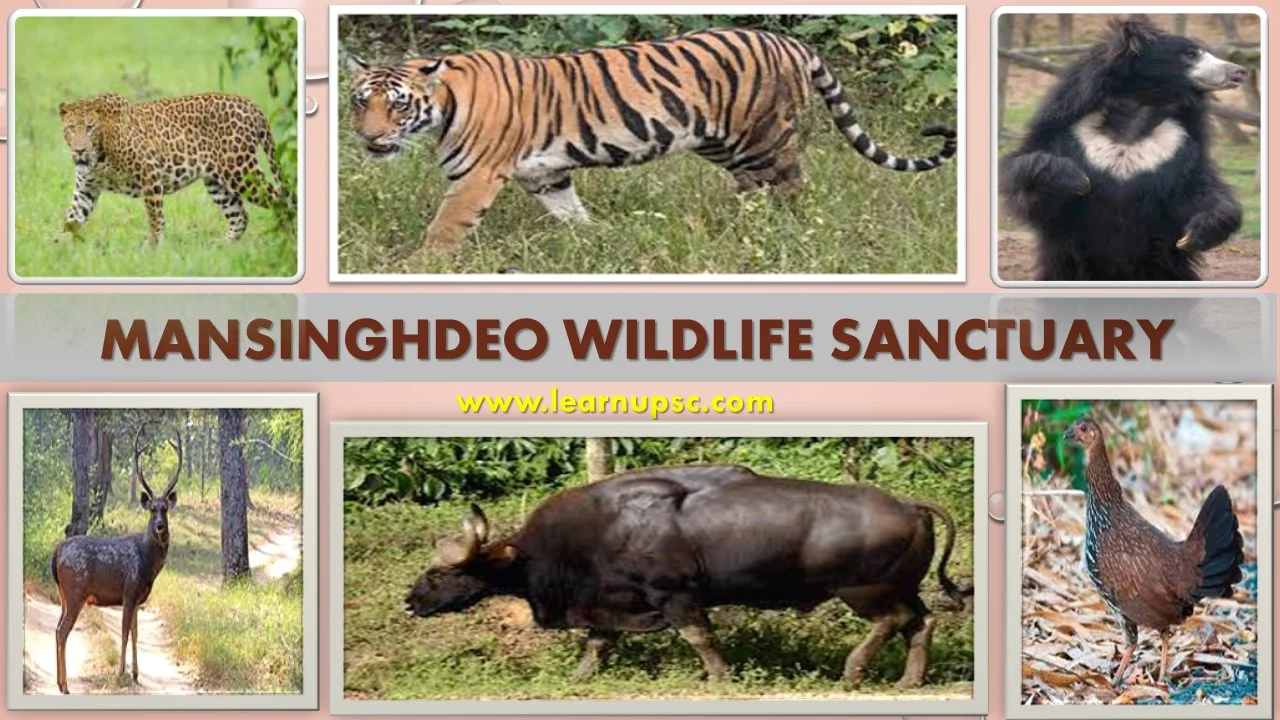Mansinghdeo Wildlife Sanctuary UPSC
Mansinghdeo Wildlife Sanctuary is a protected area situated in the state of Maharashtra, India. It was established with the primary aim of conserving the region's biodiversity, including various plant and animal species.
The sanctuary's vegetation includes a mix of tropical moist and dry deciduous forest species. It is home to various species of mammals, birds, and reptiles.
The sanctuary serves as a critical corridor for wildlife movement between neighboring protected areas (Pench Tiger Reserve), which is particularly important for maintaining genetic diversity among tiger populations.
|
Table of Contents
|
Mansinghdeo Wildlife Sanctuary Location
Mansinghdeo Wildlife Sanctuary is located in Nagpur District in the state of Maharashtra, India. It is approximately 50 kilometers away from the city of Nagpur.
Mansinghdeo Wildlife Sanctuary Nearest Airport:
The nearest airport to Mansinghdeo Wildlife Sanctuary is Dr. Babasaheb Ambedkar International Airport, which is located in Nagpur, Maharashtra, India.
Mansinghdeo Wildlife Sanctuary Nearest Railway Station:
The nearest railway station to Mansinghdeo Wildlife Sanctuary is Nagpur Junction, also located in Nagpur. This railway station is a major hub in the region and is well-connected to various other cities and towns through the Indian railway network.
Mansinghdeo Wildlife Sanctuary History
Establishment: Mansinghdeo Wildlife Sanctuary holds a significant place in the conservation efforts of the region. Established on November 2nd, 2010, this protected area emerged from a collective vision to preserve the region's rich biodiversity and natural heritage.
Preserving Critical Connectivity: One of the central reasons for the establishment of Mansinghdeo Wildlife Sanctuary was to provide a crucial ecological corridor connecting various national parks and wildlife sanctuaries in the vicinity. This connectivity plays a pivotal role in facilitating the movement of wildlife, particularly tiger populations. By offering this lifeline between protected areas, the sanctuary contributes significantly to maintaining genetic diversity and ensuring the survival of these majestic creatures.
Mansinghdeo Wildlife Sanctuary Area
Mansinghdeo Wildlife Sanctuary covers an area of approximately 182.39 square kilometers. The sanctuary's substantial land area is dedicated to conserving the diverse flora and fauna that inhabit the region's tropical moist and dry deciduous forests.
Through its significant size and ecological significance, Mansinghdeo Wildlife Sanctuary contributes to the preservation of biodiversity and provides a vital corridor for wildlife movement between nearby protected areas.
Mansinghdeo Wildlife Sanctuary Flora
Mansinghdeo Wildlife Sanctuary is home to a diverse range of flora, reflecting the variety of habitats within its boundaries. The sanctuary's vegetation includes species adapted to both tropical moist and dry deciduous forest ecosystems.
Here are some of the notable flora found within the sanctuary:
Teak (Tectona grandis): Teak is a prominent and valuable tree species known for its high-quality timber. It is often found in deciduous forests and is highly valued for its durability and strength.
Saja (Terminalia elliptica): Saja is a deciduous tree species that can grow to considerable heights. Its wood is used for various purposes, and it is also valued for its medicinal properties.
Bijiayasal (Pterocarpus marsupium): Also known as Indian kino tree, bijiayasal is a deciduous tree with red heartwood. It is valued for its medicinal properties and is used in traditional medicine.
Lendia (Lagerstroemia parviflora): Lendia is a small to medium-sized deciduous tree with attractive purple flowers. It is known for its ornamental value and is also used in traditional medicine.
Haldu (Adina cordifolia): Haldu is a deciduous tree with heart-shaped leaves. It is known for its timber and is used in making furniture and other wooden items.
Dhaora (Anogeissus latifolia): Dhaora is a hardwood tree species found in dry deciduous forests. It has strong and durable wood, making it useful for various purposes.
Salai (Boswellia serrata): Also known as Indian frankincense, salai is a tree known for its resin, which has traditional medicinal uses. The resin is extracted and used in Ayurvedic medicine.
Aonla (Emblica officinalis): Aonla, also called Indian gooseberry, is a deciduous tree known for its fruit, which is rich in vitamin C and has various health benefits.
Amaltas (Cassia fistula): Amaltas, also known as Indian laburnum, is a flowering tree with bright yellow blossoms. It is cultivated for its ornamental value.
Bamboo: Bamboo is a fast-growing grass that forms thickets in various ecosystems. It has numerous uses, including construction, crafts, and even as a food source for some animals.
Mahua (Madhuca longifolia): Mahua is a tree that produces edible flowers, seeds, and oil. It has cultural and economic importance in many parts of India.
Mansinghdeo Wildlife Sanctuary Fauna (Mansinghdeo Wildlife Sanctuary Animals)
Mansinghdeo Wildlife Sanctuary is home to a rich and diverse range of fauna, including various mammals, birds, reptiles, and other animals. The sanctuary's varied habitats, which include tropical moist and dry deciduous forests, provide suitable conditions for a wide array of species.
Here are some of the notable fauna found within Mansinghdeo Wildlife Sanctuary:
Mammals:
- Tiger
- Sloth Bear
- Leopard
- Gaur
- Sambar
- Bluebull
- Wild Boar
- Jungle Cat
- Barking Deer
Birds:
- Peafowl
- Junglefowl
- Crow Pheasant
- Crimson-breasted Barbet
- Red-vented Bulbul
- Racket-Tailed Drongo
- Indian Roller
- Magpie Robin
- Lesser Whistling Teal
- Pintail
- Shoveller
- Common Kingfisher
Reptiles:
- Indian Python
- Common Indian Monitor
- Indian Cobra
- Russell’s Viper
Mansinghdeo Wildlife Sanctuary UPSC Questions
Q. Where is Mansinghdeo Wildlife Sanctuary?
A. Mansinghdeo Wildlife Sanctuary is located in Nagpur District in the state of Maharashtra, India. It is situated approximately 50 kilometers away from the city of Nagpur, which is a major urban center in the region.


No comments:
Post a Comment